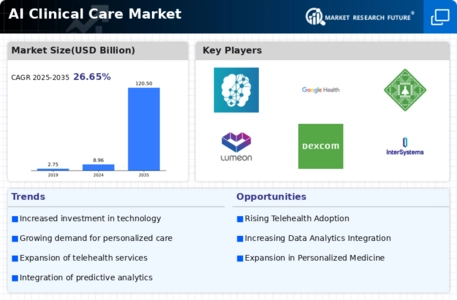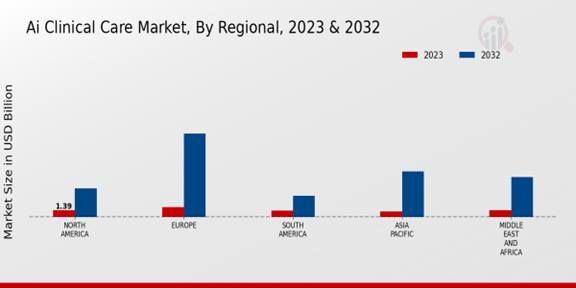Market Growth Projections
The Global AI Clinical Care Market Industry is poised for substantial growth, with projections indicating a market value of 120.5 USD Billion by 2035. This growth trajectory reflects a compound annual growth rate of 26.65% from 2025 to 2035, underscoring the increasing integration of AI technologies in clinical settings. As healthcare systems worldwide recognize the potential of AI to enhance patient outcomes and operational efficiencies, the market is likely to expand rapidly. The anticipated growth presents opportunities for stakeholders across the healthcare spectrum, from technology developers to healthcare providers.
Regulatory Support for AI Innovations
Regulatory support plays a crucial role in shaping the Global AI Clinical Care Market Industry. Governments are increasingly establishing frameworks that promote the safe and effective use of AI technologies in healthcare. These regulations aim to ensure patient safety while fostering innovation, creating an environment conducive to the adoption of AI solutions. For example, streamlined approval processes for AI-driven medical devices can expedite their entry into the market, allowing healthcare providers to benefit from cutting-edge technologies. This supportive regulatory landscape is likely to encourage further investment and development in AI clinical applications.
Rising Demand for Personalized Medicine
The Global AI Clinical Care Market Industry experiences a notable surge in demand for personalized medicine, driven by advancements in genomics and patient data analytics. Healthcare providers increasingly leverage AI technologies to tailor treatment plans to individual patient profiles, enhancing therapeutic efficacy. As of 2024, the market is valued at 8.96 USD Billion, reflecting a growing recognition of the importance of personalized approaches in clinical settings. This trend is expected to continue, with projections indicating a market expansion to 120.5 USD Billion by 2035, suggesting a robust compound annual growth rate of 26.65% from 2025 to 2035.
Integration of AI in Diagnostic Processes
The integration of AI into diagnostic processes significantly transforms the Global AI Clinical Care Market Industry. AI algorithms enhance the accuracy and speed of diagnostics, enabling healthcare professionals to make informed decisions swiftly. For instance, AI-driven imaging tools can analyze radiological images with remarkable precision, reducing the likelihood of misdiagnosis. This technological advancement not only improves patient outcomes but also streamlines operational efficiencies within healthcare facilities. As the industry evolves, the reliance on AI for diagnostics is expected to grow, further solidifying its role in clinical care.
Increased Investment in Healthcare Technology
Investment in healthcare technology is a primary driver of growth within the Global AI Clinical Care Market Industry. Governments and private entities are channeling substantial resources into AI research and development, recognizing its potential to revolutionize patient care. This influx of capital facilitates the development of innovative AI solutions that address various healthcare challenges, from predictive analytics to automated patient monitoring. As the market matures, the financial backing is likely to foster a competitive landscape, encouraging the emergence of new players and technologies that enhance clinical care delivery.
Growing Aging Population and Chronic Disease Prevalence
The Global AI Clinical Care Market Industry is significantly influenced by the growing aging population and the rising prevalence of chronic diseases. As the demographic landscape shifts, healthcare systems face increasing pressure to manage complex health conditions effectively. AI technologies offer solutions that enhance care delivery for elderly patients and those with chronic illnesses, such as remote monitoring and predictive analytics. This trend is expected to drive market growth, as healthcare providers seek innovative ways to address the unique challenges posed by an aging population and the associated healthcare demands.













